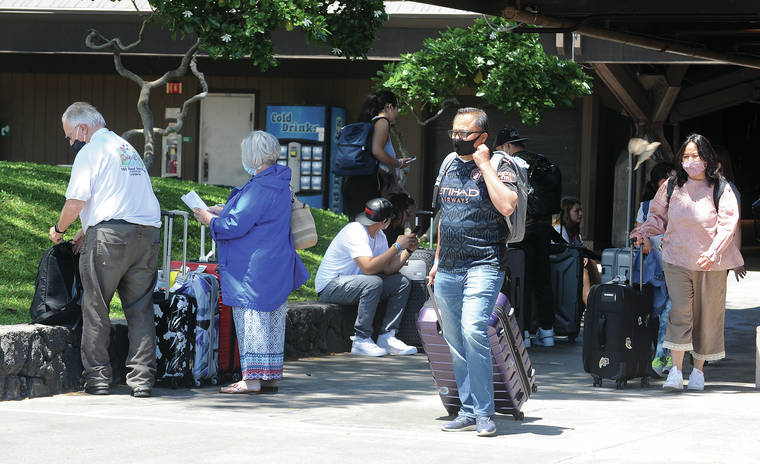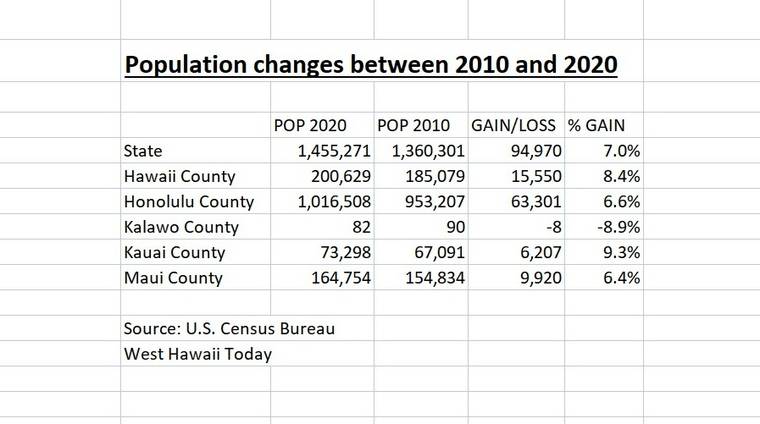Hawaii Island topped the 200,000 population mark and Oahu passed one million people in data released Thursday by the U.S. Census Bureau.
In the first count of the total population in a decade, the bureau found Hawaii’s four major counties experienced population increases, bucking the trend of more than half the nation’s 3,143 counties or equivalents losing population over the last decade. Instead, population growth over most of the United States was concentrated in cities and close suburbs.
The official count that sets the stage for political boundaries for the next 10 years also defied annual estimates the Census Bureau has released over the past decade, with the new numbers showing Oahu grew much more than estimated, which could torpedo Hawaii Island’s hopes for an eighth seat in the state House.
“The numbers released surprised me with the Honolulu number being higher and the Big Island number lower than I expected,” said Eugene Tian, research and economic analysis division administrator for the state Department of Business, Economic Development and Tourism.
Tian said his office’s projections based on Census Bureau annual estimates ere quite different for those two counties, but the decennial census numbers are more accurate than the estimates in the off years.
“This 2020 census is more accurate because it’s a door-to-door survey,” Tian said.
Hawaii County’s 200,629 residents was an increase of 15,550 people, a 8.4% increase from 2010. In comparison, Oahu gained 63,301 people to a population of 1.02 million, a 6.6% increase. Maui County’s 9,920 extra people was a 6.4% increase to 164,754 and Kauai’s 6,207 additional people brought its population to 73,298, a 9.3% increase.
That means Oahu has an average 29,043 residents in each of its 35 House districts, Hawaii Island has 28,661 residents in each of its seven districts, Maui has 27,459 in each of its six districts and Kauai has 24,433 in each of its three districts.
Those numbers will adjust slightly when nonresident military and students, mostly on Oahu, are removed from the statewide counts. The state reapportionment staff has estimated 71,162 should be removed, while the Census Bureau for the first time has compiled its own lists of various types of group quarters, including students and military.
The numbers, released for levels of geography down to the smallest, the census block, will be used by the state and county reapportionment and redistricting commissions to set boundaries for state and local offices before next year’s election.
The point of reapportionment is to ensure equal representation for all residents. The goal is to draw legislative districts with as close to the same number of people as possible.
The Supreme Court has presumed a plan is unconstitutional if districts are 10% larger or smaller than the ideal population, which is derived by dividing the total population by the number of districts.
Dylan Nonaka, a member of the state Reapportionment Commission — the nine-member body charged with setting boundaries for Hawaii’s two congressional districts and state legislative offices — said the commission next meets Aug. 26. The first order of business will be to set guidelines for reapportioning districts by island group. The commission needs to decide how it will go about extracting nonresidents and make a decision on whether canoe districts — where a state legislator represents parts of two or more islands — will be allowed, he said.
“It’s hard to speculate at this time,” Nonaka said Thursday.
Trying to count the population on April 1, 2020, during the continuing coronavirus pandemic didn’t make the Census Bureau’s job easy, and the agency missed several deadlines getting the numbers to the state so they could set boundaries in time for candidate qualifying. Still, said Acting Director Ron Jarmin, the bureau stands by its data.
“We have produced the reliable and usable statistics that we and the public expect,” Jarmin said at a Thursday press conference. “While no census is perfect, we are confident that today’s redistricting results meet our high data-quality standards.”









